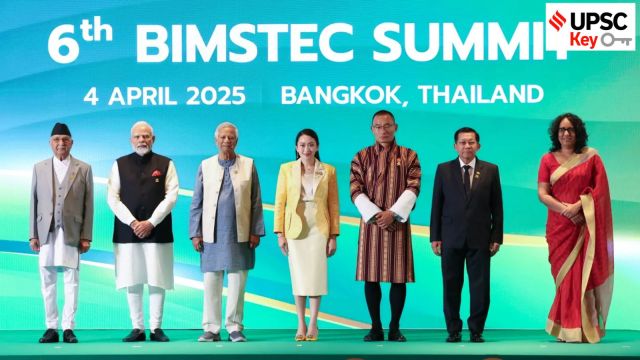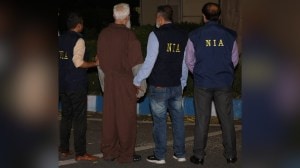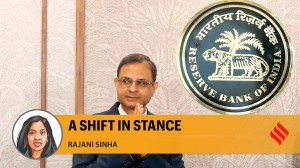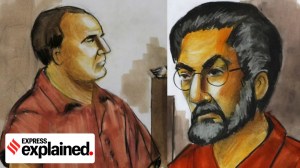UPSC Key: PM’s BIMSTEC initiatives, Ottawa Convention and Remittances
How is BIMSTEC relevant to the UPSC exam? What significance do topics like the Ottawa Convention, the new pattern of remittances and India-Bangladesh relations have for both the preliminary and main exams? You can learn more by reading the Indian Express UPSC Key for April 5, 2025.
 Know more about the 6th BIMSTEC Summit in our UPSC Key. (X/@narendramodi)
Know more about the 6th BIMSTEC Summit in our UPSC Key. (X/@narendramodi)Important topics and their relevance in UPSC CSE exam for April 5, 2025. If you missed the April 4, 2025 UPSC CSE exam key from the Indian Express, read it here
FRONT PAGE
UPI, energy links, trade in local currency: PM Modi’s BIMSTEC initiatives
Syllabus:
Preliminary Examination: Current events of national and international importance
Mains Examination: General Studies-II: Bilateral, regional and global groupings and agreements involving India and/or affecting India’s interests.
What’s the ongoing story: Underlining that BIMSTEC is a model for inclusive development and collective security and not merely a regional organisation, Prime Minister Narendra Modi Friday announced more than 20 initiatives — from the mechanism of Home Ministers on security to UPI connecting payment mechanisms, an energy centre to a chamber of commerce.
Key Points to Ponder:
• What is BIMSTEC?
(Thought Process: Know about the history of BIMSTEC, its objectives, member countries.)
• How is BIMSTEC different from SAARC?
• What is Bangkok Vision 2030?
• What is BIMSTEC for Organized Development of Human Resource Infrastructure (BODHI) initiative?
• What is the significance of BIMSTEC for India?
• Map work: Locate BIMSTEC member countries on map (Refer Atlas)
Key Takeaways:
• Speaking at the 6th BIMSTEC Summit in Bangkok, Modi said, “BIMSTEC serves as a vital bridge between South and Southeast Asia, and is emerging as a powerful platform for advancing regional connectivity, cooperation and shared prosperity.”
• “It is a matter of great satisfaction that the BIMSTEC Charter came into force last year. I am confident that the Bangkok Vision 2030, which we are adopting today, will further our collective commitment to building a prosperous, secure and inclusive Bay of Bengal region,” he said.
• India revived the BIMSTEC grouping in 2016 after the SAARC summit was cancelled. India boycotted the SAARC summit after the Pakistan-sponsored terror attack in Uri. Pakistan is not a member of the BIMSTEC grouping which has Bangladesh, Bhutan, India, Myanmar, Nepal, Sri Lanka and Thailand — countries dependent on the Bay of Bengal.
• On security cooperation, Modi said, “To further strengthen BIMSTEC, we must continue to expand its scope and enhance its institutional capacities. It is encouraging to note that the Home Ministers’ mechanism is being institutionalised. This forum can play a major role in the fight against cyber crime, cyber security threats, terrorism, drug trafficking and human trafficking. In this regard, I propose that India host the first meeting of this mechanism later this year.”
• He also proposed establishing connectivity between India’s Unified Payments Interface (UPI) and the payment systems of BIMSTEC member states.
• On trade and business, he proposed the establishment of a BIMSTEC Chamber of Commerce. Additionally, an annual BIMSTEC Business Summit will be organised to foster greater economic engagement.
• Stating that public health is a vital pillar, Modi announced that India will extend support for training and capacity building in cancer care across BIMSTEC countries.
• On space cooperation, he proposed the establishment of a ground station for manpower training, the development and launch of nano-satellites and use of remote sensing data for the BIMSTEC countries.
• On skilling the youth, he said, “We are launching the BODHI initiative, i.e. ‘BIMSTEC for Organized Development of Human Resource Infrastructure’ initiative. Under this programme, 300 young individuals from BIMSTEC member countries will receive training in India each year.”
• To enhance cultural links, he said India will host the inaugural BIMSTEC Traditional Music Festival later this year.
Do You Know:
• Prime Minister Modi recently visited Thailand to attend the 6th Bay of Bengal Initiative for Multi-Sectoral Technical and Economic Cooperation (BIMSTEC) summit. It was the first physical meeting of the BIMSTEC leaders since the 4th BIMSTEC Summit in Kathmandu, Nepal, in 2018. The last summit was held in Colombo in March 2022 in virtual format.
• The theme of the sixth BIMSTEC summit is “Prosperous, resilient, and open BIMSTEC (PRO BIMSTEC).
• BIMSTEC includes countries of the Bay of Bengal region, and seeks to act as a bridge between South and Southeast Asia. Originally formed as BIST-EC (Bangladesh, India, Sri Lanka, and Thailand Economic Cooperation) in 1997, it became BIMST-EC after Myanmar joined, and BIMSTEC in 2004 with the inclusion of Nepal and Bhutan. It received a charter at the 2022 Colombo summit, which came into effect last year after all members ratified it.
Other Important Articles Covering the same topic:
📍PM Modi’s Sri Lanka, BIMSTEC visits highlight India’s regional commitments
📍Knowledge Nugget: What should you know about BIMSTEC and SAARC for UPSC?
UPSC Prelims Practice Question Covering similar theme:
(1) Consider the following countries :
1. Bangladesh
2. Bhutan
3. Pakistan
4. Thailand
5. Sri Lanka
Which of the above are members of both SAARC and BIMSTEC?
(a) 1, 2 and 4 only
(b) 1 and 4 only
(c) 2 and 5 only
(d) 1, 2 and 5 only
Avoid rhetoric that vitiates environment, PM Modi tells Yunus after his remarks on N-E
Syllabus:
Preliminary Examination: Current events of national and international importance
Mains Examination: General Studies-II: India and its neighbourhood- relations.
What’s the ongoing story: In their first meeting since the ouster of Sheikh Hasina last August, Prime Minister Narendra Modi and Bangladesh interim government Chief Adviser Prof Muhammad Yunus Friday underlined their concerns upfront.
Key Points to Ponder:
• What is the history of the Liberation of Bangladesh and what role did India play in it?
• What are the areas of cooperation between India and Bangladesh?
• What are the challenges in India and Bangladesh ties?
• Bangladesh’s request for the extradition of former Prime Minister Sheikh Hasina from India and its diplomatic implications-Know in detail
• How does the political transition in Bangladesh and its impact on India’s foreign policy underscores the importance of neighbourhood diplomacy?
• Why is India-Bangladesh relations important in the context of regional stability and connectivity?
• Map work: Location of Bangladesh and Indian states sharing boundaries with Bangladesh.
Key Takeaways:
• During talks said to be a sharp 40-minute meeting on the sidelines of the BIMSTEC summit in Bangkok, Modi raised the issue of the safety of Hindus and other minorities who have been targeted in Bangladesh while Yunus asked him about Dhaka’s request for the extradition of Hasina who fled to India after her ouster.
• Modi told Yunus that “rhetoric that vitiates the environment is best avoided”, an Indian government statement said — during his visit to Beijing late last month, Yunus, while seeking “extension of the Chinese economy”, had said that North-East India was “landlocked” and Bangladesh was the “only guardian of the ocean for all this region”, a remark that did not go down well in Delhi.
• “He (Modi) also underlined India’s concerns related to the safety and security of minorities in Bangladesh, including Hindus, and expressed his expectation that the Government of Bangladesh would ensure their security, including by thoroughly investigating the cases of atrocities committed against them,” the Ministry of External Affairs said.
• Yunus enquired about the status of the Bangladesh request for the extradition of Hasina which remains pending with Delhi.
• Yunus also pointed to the Human Rights Commission’s report about violations and abuses committed by security forces and armed Awami League activists between July 15 and August 5, 2024, in which 1,400 protest-related deaths occurred, approximately 13 per cent of the victims being children.
• The Indian statement said Prime Minister Modi reiterated India’s support for a “democratic, stable, peaceful, progressive and inclusive Bangladesh” — all pointing to a government that comes about after elections and there is peace on the streets, and minorities are taken care.
• In the past, Yunus has said that the elections are to take place later this year or by early 2026. Political parties including the BNP have been pushing for early elections in Bangladesh.
• On the overall relationship, the Indian statement said Prime Minister Modi “expressed his conviction that all issues of mutual interest between the two countries would continue to be addressed and resolved bilaterally through constructive discussions, in the interest of their long standing and mutually beneficial bilateral relationship”.
• The Bangladesh statement also sought to give a positive framing: “Bangladesh deeply values its relationship with India. The deep-rooted friendship between our two countries is founded on intertwined histories, geographical proximity, and cultural affinity. We remain thankful for the unwavering support of the government and people of India during our most challenging time in 1971.”
Do You Know:
• The turmoil in Bangladesh in August last year resulted in the ouster of former Prime Minister Sheikh Hasina and the establishment of an interim government led by Nobel laureate Muhammad Yunus. This event is considered a significant turning point in Bangladesh’s history and has introduced new dynamics in regional politics. As a neighbouring country of India, Bangladesh has always played a crucial role in India’s “neighbourhood first” policy.
• Assam, West Bengal, Mizoram, Meghalaya, and Tripura share borders with Bangladesh.
Other Important Articles Covering the same topic:
📍Why India-Bangladesh extradition treaty does not imply that New Delhi must hand over Sheikh Hasina
Previous year UPSC Prelims Question Covering similar theme:
(2) With reference to river Teesta, consider the following statements: (UPSC CSE 2017)
1. The source of river Teesta is the same as that of Brahmaputra but it flows through Sikkim.
2. River Rangeet originates in Sikkim and it is a tributary of river Teesta.
3. River Teesta flows into Bay of Bengal on the border of India and Bangladesh.
Which of the statements given above is/are correct?
(a) 1 and 3 only
(b) 2 only
(c) 2 and 3 only
(d) 1, 2 and 3
(3) ‘Exercise SAMPRITI’ is a military exercise between India and which of the following nations?
(a) Bangladesh
(b) Sri Lanka
(c) Nepal
(d) Thailand
GOVT & POLITICS
Modi meets Myanmar junta chief, calls for ‘credible’ polls
Syllabus:
Preliminary Examination: Current events of national and international importance
Mains Examination: General Studies-II: India and its neighbourhood- relations.
What’s the ongoing story: In his first meeting with Myanmar junta chief Min Aung Hlaing since the February 2021 coup, Prime Minister Narendra Modi Friday pushed for early restoration of the democratic process in the country through “inclusive and credible elections”. This is the first time that India has called for elections in Myanmar at the highest level.
Key Points to Ponder:
• What is the history of India-Myanmar relations?
• What are the areas of cooperation between India and Myanmar?
• What are the challenges in India and Myanmar relations?
• What is the significance of Myanmar for India?
• What is India’s Neighbourhood First Policy?
• Read about the recent earthquake in Myanmar.
• What is Operation Brahma?
• What are the Indian states sharing a boundary with Myanmar?
Key Takeaways:
• During the meeting on the sidelines of the BIMSTEC summit in Bangkok, Modi also called for inclusive dialogue to end the civil war in Myanmar. He offered to ramp up aid in the aftermath of the devastating earthquake that killed over 3,000 people. The PM also called for the post-earthquake ceasefire to be made permanent, Ministry of External Affairs (MEA) spokesperson Randhir Jaiswal said.
• The MEA said in a statement that Modi “underlined the importance of early restoration of a democratic process through inclusive and credible elections, adding that India supported efforts aimed at fostering trust and advancing a Myanmar-owned and Myanmar-led transition towards a peaceful, stable and democratic future”.
• The leaders discussed the earthquake in Myanmar, including India’s aid efforts. The chief of Myanmar’s military government “expressed his gratitude for India’s assistance efforts”.
• India has deployed military field hospitals in Mandalay, which was near the epicentre of the earthquake. It has also sent National Disaster Response Force (NDRF) personnel who are assisting in the relief work in Myanmar.
• The junta chief also attended an official dinner for leaders of the BIMSTEC nations. The Thai Ministry of Foreign Affairs said BIMSTEC members discussed disaster management during ministerial meetings on Thursday.
Do You Know:
• India on Saturday (March 29) delivered 15 tonnes of relief materials to Myanmar under its ‘Operation Brahma’ that was launched after a powerful earthquake hit the Myanmar and Thailand. India sent a search and rescue team and a medical team as well as provisions. A C130J aircraft delivered supplies, including tents, blankets, food, water purifiers, and medicines, to Yangon. Two more IAF aircraft carrying aid will depart soon, officials said.
• India has acted as a “First Responder” to assist the people of Myanmar affected by Friday’s massive earthquake, External Affairs Ministry spokesperson Randhir Jaiswal said.
Other Important Articles Covering the same topic:
UPSC Prelims Practice Question Covering similar theme:
(4) India has delivered relief materials to which of the following countries under its Operation Brahma?
(a) Nepal
(b) Maldives
(c) Mauritius
(d) Myanmar
EXPLAINED
Which countries are quitting a key landmine treaty and why?
Syllabus:
Preliminary Examination: Current events of national and international importance
Mains Examination: General Studies-II: Effect of policies and politics of developed and developing countries on India’s interests.
What’s the ongoing story: NATO members Poland, Finland and all three Baltic states have queued up over the past few weeks to withdraw from the Ottawa Convention banning anti-personnel landmines, in the face of what they say are growing military threats from Russia.
Key Points to Ponder:
• Read about NATO.
• What is the Ottawa Convention?
• What is the primary objective of the Ottawa Convention?
• Which countries have not signed or ratified the Ottawa Convention?
• What are anti-personnel landmines?
• What are the concerns associated with anti-personnel landmines?
• What are the Baltic states?
• What is the Convention on Cluster Munitions?
• Map work: Mark NATO member countries and Baltic states on map (Refer Atlas)
Key Takeaways:
• The moves threaten to reverse decades of campaigning by activists who say there should be a global ban on a weapon that blights huge swathes of territory and maims and kills civilians long after conflicts have abated.
• Countries that quit the 1997 treaty — one of a series of international agreements concluded after the end of the Cold War to encourage global disarmament — will be able to start producing, using, stockpiling, and transferring landmines once again.
• All European countries bordering Russia have announced plans to quit the global treaty. Norway, which said this week that for all the increased threats it was important to maintain the stigma around the weapons, is the sole exception.
• Many have said they fear that, as United States President Donald Trump steps up pressure to end the war in Ukraine, Russia could use any pause to re-arm and target them instead.
• Officials have suggested a withdrawal could also put them on more of an equal footing with Russia which — along with the likes of the US, China, India and Israel — has not signed or ratified the treaty.
• Some of the countries pulling out of the landmines treaty, including Lithuania, are also considering leaving the 2008 Convention on Cluster Munitions. These are explosive weapons that release smaller submunitions over a vast area.
• The US, which had also not signed that convention, in 2023 transferred cluster munitions to Ukraine to help it defend itself against Russia.
Do You Know:
• Anti-personnel landmines are generally hidden in the ground and designed to detonate automatically when someone steps on them or passes nearby.
• More than 80% of mine victims are civilians, according to the International Committee of the Red Cross (ICRC).
• The Ottawa convention includes provisions to assist victims, many of whom have lost limbs and suffer from other permanent disabilities. In October 2024, the United Nations reported that Ukraine had become the most mined country in the world. As of August 2024, it said there had been around 1,286 civilian victims of mines and explosive remnants.
• Under the terms of the 1997 convention, countries were supposed to destroy all landmine stockpiles within four years, although not all have complied, according to the ICRC.
UPSC Prelims Practice Question Covering similar theme:
(5) Which of the following countries has not signed or ratified the Ottawa Convention on Anti-Personnel Landmines?
1. United States
2. Israel
3. China
4. India
Select the correct answer using the code below:
(a) 1 and 2 only
(b) 1, 2 and 3 only
(c) 1, 3 and 4 only
(d) 1, 2, 3 and 4
A new pattern of remittances
Syllabus:
Preliminary Examination: Current events of national and international importance.
Main Examination: General Studies-II, III: Indian diaspora, Indian Economy and Mobilization of Resources.
What’s the ongoing story: Findings of the Reserve Bank of India’s (RBI’s) latest Remittances Survey released last month show a significant shift in India’s remittance sources.
Key Points to Ponder:
• What are Remittances?
• What are the factors behind the recent change in pattern of remittances to India?
• What is the Gulf Cooperation Council (GCC) and its member countries?
• What are the key factors contributing to the decline in remittances from GCC countries to India?
• What policy measures can India adopt to improve the welfare of both low-skilled and high-skilled migrant workers abroad?
• How do nationalisation policies in destination countries affect India’s labour migration and remittance dynamics?
• What is Saudisation?
• What is meant by the Indian diaspora? Why is the Indian diaspora important?
Key Takeaways:
• The Advanced Economies (AEs) — particularly the United States, the United Kingdom, Singapore, Canada, and Australia — together accounted for more than half the total remittances in 2023-24, overtaking the Gulf Cooperation Council (GCC) countries, which have traditionally contributed the largest share of remittances to India.
• This shift allows India to further leverage remittances from Indians working abroad for development in the country. But it also raises important questions about the changing patterns of migration overseas, India’s economic policies, and the evolving nature of challenges faced by Indian workers abroad.
• Historically, the six GCC nations — Saudi Arabia, the United Arab Emirates (UAE), Qatar, Oman, Bahrain, and Kuwait — have been the biggest contributors of remittances to India because of the large numbers of Indian workers employed in those countries.
• However, multiple factors have led to a decline in remittances from the Gulf. The economic downturn caused by the Covid-19 pandemic resulted in widespread job losses and salary cuts, reducing the disposable income available for remittances.
• Additionally, “nationalisation” policies — such as the Saudi Nationalisation Scheme or Nitaqat, also known as “Saudisation” — which prioritise local employment over foreign workers, have significantly decreased opportunities for Indian migrants.
• Remittances from the AEs have risen steadily in recent years. The US remains the largest contributor, accounting for 27.7% of total remittances in 2023-24. US remittances made up 22.9% of the total in 2016-17, and 23.4% in 2020-21.
• Although the number of Indian migrants in the US is smaller than in the GCC, they send higher per capita remittances due to higher wages (including a higher minimum wage) and the greater purchasing power of the US dollar.
• This pattern is also seen in other advanced economies such as Canada, the UK, Germany, and Australia, where Indian professionals earn significantly more than their counterparts in the Gulf.
• The increasing number of highly skilled Indian professionals in advanced economies, particularly in the STEM fields, finance, and healthcare, has contributed to higher remittance inflows. Our recent research on the India-Germany, India-Austria, and the India-Netherlands corridors supports this trend.
• Remittances from AEs, especially the US, given the policies of the current administration, could increase even further.
Do You Know:
• A significant factor in the rise of remittances from the AEs is the increasing number of Indian students pursuing higher education abroad. While studying, they contribute to remittance inflows through loan repayments. After graduating and obtaining jobs, they might send remittances back home to their families.
• To maximise remittance inflows and improve the welfare of migrant workers, India must focus on skill harmonisation at the sending-country level.
• Keeping in mind individual liberties and choices, highly skilled workers must be supported for placement in roles that match their qualifications, while low-skilled workers should have access to appropriate opportunities without the risk of exploitation or forced deskilling.
• Addressing this issue will ensure that Indian migrants are able to fully utilise their skills and earn at their potential.
• Bilateral and multilateral mobility agreements can play an important role in regulating migration and protecting workers from underemployment. By proactively engaging with destination countries to establish such agreements, India can secure better opportunities for its workforce, while also ensuring a steady flow of remittances.
Other Important Articles Covering the same topic:
📍Indians abroad: History, spread, remittances
Previous year UPSC Prelims Question Covering similar theme:
(6) Which of the following constitute Capital Account? (UPSC CSE 2013)
1. Foreign Loans
2. Foreign Direct Investment
3. Private Remittances
4. Portfolio Investment
Select the correct answer using the codes given below:
(a) 1, 2 and 3 only
(b) 1, 2 and 4 only
(c) 2, 3 and 4 only
(d) 1, 3 and 4 only
Previous year UPSC Mains Question Covering similar theme:
‘Indian diaspora has a decisive role to play in the politics and economy of America and European Countries’. Comment with examples. (UPSC CSE 2020)
Can senior citizens evict family from property? What SC held
Syllabus:
Preliminary Examination: Indian Polity and Governance- Constitution, Political System, Panchayati Raj, Public Policy, Rights Issues.
Mains Examination: General Studies-II: Constitution of India —historical underpinnings, evolution, features, amendments, significant provisions and basic structure.
What’s the ongoing story: On Friday (March 28), the Supreme Court rejected a suit filed by a senior couple to evict their son from their home by invoking the Maintenance and Welfare of Parents and Senior Citizens Act, 2007 (Senior Citizens Act). The Act provides a streamlined process for senior parents — often neglected and lacking financial support — to file suits seeking maintenance from their children.
Key Points to Ponder:
• What is the Maintenance and Welfare of Parents and Senior Citizens Act, 2007 (Senior Citizens Act)?
• How has the Supreme Court interpreted the provisions of the Senior Citizens Act, 2007, in cases involving eviction of children?
• How does the Senior Citizens Act maintain balance between parental rights and children’s rights?
• What are the other legal frameworks available to protect senior citizens from abuse and neglect by their children?
Key Takeaways:
• Though the Act does not explicitly give parents the right to evict their children or relatives from their home, the Supreme Court has interpreted the provision related to property transfers to allow such eviction orders in certain circumstances.
• The Senior Citizens Act allows parents (age 60 and above) who are unable to maintain themselves “from his own earning or property owned by him” to file a suit for maintenance against their children or relatives (legal heirs). It places an obligation on these children or relatives to meet the parents’ needs “so that such parent may lead a normal life”. The Act also establishes dedicated tribunals to hear these suits, along with appellate tribunals to hear challenges to any orders passed.
• Crucially, Section 23 of the Act also gives parents an avenue to receive maintenance even after transferring or gifting their property. Under Section 23(1), a senior citizen may gift or transfer her property with a condition that the receiver “shall provide the basic amenities and basic physical needs”. If this condition is not met, the provision states that the transfer “shall be deemed to have been made by fraud or coercion or under undue influence” and can be declared void if the senior citizen approaches the tribunal.
• Section 23(2) states that senior citizens have a right to receive maintenance from an estate, and if this estate is transferred (wholly or partially), this right can be enforced against the new owner of the estate so long as they are made aware of this right.
• The court was tasked with hearing a suit filed by parents seeking to evict their son from their home, claiming that he had neglected to take care of them and was torturing them mentally and physically. In 2019, a tribunal under the Senior Citizens Act granted limited relief to the parents, ordering the son not to encroach upon any part of the house without the permission of his parents, confining him to the utensil shop he ran out of the same building and the room where he resides with his wife and children. The tribunal also stated that eviction proceedings could only be revived if the son further misbehaved or tortured his parents.
• Unsatisfied with this order, the parents appealed the decision and eventually approached the Supreme Court in 2023. However, the court held that “There is no complaint or any material on record to indicate that after the aforesaid order Krishna Kumar has in any way humiliated his parents”. The court also clarified that “it is not necessary and mandatory to pass an order of eviction in every case”.
Previous year UPSC Prelims Question Covering similar theme:
(7) What is the position of the Right to Property in India? (UPSC CSE 2021)
(a) Legal right available to citizens only
(b) Legal right available to any person
(c) Fundamental Right available to citizens only
(d) Neither Fundamental Right nor legal right
THE EDITORIAL PAGE
Well judged
Syllabus:
Preliminary Examination: Current events of national importance and Polity
Mains Examination: General Studies-II: Structure, organisation and functioning of the Executive and the Judiciary, Accountability and ethical governance.
What’s the ongoing story: The Supreme Court’s decision that judges should publicly declare their assets is welcome and significant, because it prioritises transparency and openness.
Key Points to Ponder:
• What are the constitutional provisions related to the Indian judiciary?
• What is the Supreme Court Collegium?
• How does the balance between judicial independence and accountability manifest in cases involving allegations against judges?
• What reforms could be introduced to enhance transparency in judicial enquiries, appointments, and disciplinary actions?
• Is the Indian judiciary covered under the Lokpal and Lokayukta Act, 2013?
• Read about the National Judicial Appointments Commission (NJAC) Act.
• What is the Right to Information Act? Is the judiciary covered under it?
• What is the procedure for the impeachment of a judge?
Key Takeaways:
• In 1997, the SC had first resolved to publicly disclose judges’ assets when it adopted a code of ethics for the judiciary, the Restatement of Values of Judicial Life. Now, in a full court meeting on April 1, all judges have unanimously reaffirmed this code, agreeing to put up a list of their assets in the public domain.
• A 2009 Delhi High Court ruling, while upholding the disclosure of judges’ assets under the Right to Information Act, had said that “all power — judicial power being no exception — is held accountable in a modern Constitution. Holders of power too are expected to live by the standards they set, interpret, or enforce, at least to the extent their office demands. Conventions and practices, long followed, are known to be legitimate sources, and as binding upon those concerned, as the express provisions themselves.”
• At a time when a sitting High Court judge, Justice Yashwant Varma, faces allegations that unaccounted cash was found at his official residence, Chief Justice of India Sanjiv Khanna’s decision sends a much-needed signal that the judiciary is looking within in order to create institutional mechanisms of accountability.
• In 2015, even as it struck down as unconstitutional the National Judicial Appointments Commission — which gave the government a foot in the door in the matter of appointing judges — the SC acknowledged that steps had to be taken to ensure accountability of judges. Now, a decade later, the two recent incidents in which questions have been raised over the conduct of judges have pointed to the continuing lack of an institutional framework.
• The Constitution sets a high bar for the impeachment of a judge, making it virtually impossible without political consensus. Even the decision to initiate an in-house inquiry is solely in the hands of the CJI, who, increasingly, has a short tenure. At the same time, informal solutions to deal with corruption, such as the transfer of a judge or withdrawal of judicial work from him, have been woefully inadequate.
• The Collegium’s transfer policy, mostly shrouded in secrecy, for judges in the dock is now being questioned by the Bar — in the last two weeks, the Allahabad and Calcutta Bar protested the repatriation of judges to their respective high courts. That is why even though the Court’s decision to disclose assets is a step in the right direction to retain public trust in the institution, much more needs to be done.
• It is also important that the framework of accountability comes from within the judiciary — so that the institution can preserve its independence. In fact, the judiciary must acknowledge that accountability is a facet of its independence.
Do You Know:
• The Justice M N Venkatachaliah Commission, appointed by Prime Minister Atal Bihari Vajpayee in 2000, recommended the creation of a National Judicial Appointments Commission (NJAC) to replace the collegium.
• In August 2014, Parliament passed the Constitution (99th Amendment) Act, 2014, and the National Judicial Appointments Commission (NJAC) Act, 2014. These two laws provided for an independent commission to appoint judges to the SC and High Courts, replacing the collegium system.
• The NJAC was to comprise the Chief Justice of India as the ex officio Chairperson, two senior-most Supreme Court Judges as ex officio members, the Union Minister of Law and Justice as ex officio member, and two eminent persons from civil society — one of whom would be nominated by a committee consisting of the CJI, Prime Minster and the Leader of Opposition in the Lok Sabha, and the other would be nominated from the SC/ST/OBC/minority communities or women. The laws were repealed in October 2015 after the Supreme Court struck them down.
Other Important Articles Covering the same topic:
Previous year UPSC Prelims Question Covering similar theme:
(8) Consider the following statements: ( UPSC CSE 2019)
1. The 44th Amendment to the Constitution of India introduced an Article placing the election of the Prime Minister beyond judicial review.
2. The Supreme Court of India struck down the 99th Amendment to the Constitution of India as being violative of the independence of judiciary.
Which of the statements given above is/are correct?
(a) 1 only
(b) 2 only
(c) Both 1 and 2
(d) Neither 1 nor 2
Previous year UPSC Mains Question Covering similar theme:
Critically examine the Supreme Court’s judgment on ‘National Judicial Appointments Commission Act, 2014’ with reference to the appointment of judges of higher judiciary in India. (UPSC CSE 2017)
His name is bully
Syllabus:
Preliminary Examination: Current events of national and international importance
Main Examination: General Studies II: Effect of policies and politics of developed and developing countries on India’s interest.
What’s the ongoing story: Pratap Bhanu Mehta writes- “Donald Trump’s imperious destruction of the global trading order prompts the question: How should countries react to this moment?”
Key Points to Ponder:
• What are tariffs and how do tariffs work?
• What are the key reasons behind the recent US government’s decision to increase tariffs?
• How do countries generally retaliate against tariffs, and what are the potential consequences of such retaliatory measures?
• In what ways can the Trump administration’s tariff policies impact India’s economy and trade relations with the U.S.?
• What are the areas of cooperation between India and the US?
• What strategies should India employ to navigate potential trade negotiations with the U.S.?
• What is the bilateral trade agreement between India and the USA?
Key Takeaways:
• “In India, there is a viewpoint that wants to convert this moment into an opportunity by placating Trump. By this view, India should have lower tariffs anyway. That we get there under external pressure is fine. And if it ingratiates India with Trump early even better. But this view is myopic and misunderstands the nature of Trump’s actions. It will be in India’s long-term interest to artfully mount global collective resistance to Trump’s imperiousness, rather than succumb to extortion.”
• “The idea of freer trade, which both the Left and Right have maligned, is a desirable objective and a magnificent intellectual idea. There are well-argued exceptions to the presumption in favour of trade. Societies also need to embed trade in prudential judgements about domestic political legitimacy and security. We can have a separate academic argument about lowering tariffs. But it is naïve to think that, appearances notwithstanding, what Trump is trying to unleash is a race to lower tariffs and opening trade. What he is engaging in is imperial power play.”
• “Trump’s tariffs are not about tariff reciprocity; they are about balancing trade on a bilateral basis, which is an absurd idea. Even if you end up with reciprocal tariffs, Trump will up the ante on volumes on balancing and so forth, as the tariffs imposed on Israel, America’s closest ally, suggest. It would be foolish to assume that once you have negotiated tariff levels with the US that will be the end of the matter. Instead, what you are opening yourself up to is endless haggling and uncertainty.”
• “Trump’s play on tariffs must be seen in the context of the larger wrecking ball he has thrown at the world system; it is not just a technical economic issue. The complete collapse of the credibility of the American state that Trump exemplifies ought to be taken seriously. It is felt even by its closest allies.”
• “American foreign policy always had an imperial element, often driven by a desire to control natural resources. Power is used to open markets and access resources. But that imperial policy was checked by at least a modicum of commitment to interdependence, an ideological commitment to the idea that there cannot be a global trading system that is a zero sum-game system. Trump rejects that meta idea; trade is now entirely about American primacy.”
• “India’s sclerotic development has left us with little leverage. But the lesson we should draw from this is: There must be a renewed national commitment to development on all fronts. We must not peddle the illusion that tariff concessions under conditions of being bullied are a path to development.”
• “Trump is engaging in price discovery. Some have suggested that those who respond favourably to Trump early will receive better deals. But none of these deals will be dependable. Our long-term interest lies in a strong signal that India is not a pushover, it will do things on its terms and for its needs.”
Do You Know:
• Tariffs are taxes or duties imposed by a government on imported goods and services. Their objective is to make foreign products more expensive compared to domestically produced goods, thereby encouraging consumers to prefer local products. Tariffs also act as a protective measure for domestic industries against foreign competition. Additionally, they serve as a source of revenue for the government.
Other Important Articles Covering the same topic:
📍UPSC Issue at a Glance | Tariff war: 4 Key Questions You Must Know for Prelims and Mains
UPSC Previous Year Mains Question Covering similar theme:
What are the key areas of reform if the WTO has to survive in the present context of ‘Trade War’, especially keeping in mind the interest of India? (UPSC CSE 2018)
| ALSO IN NEWS | |
| Cabinet nod to Vibrant Villages Programme Ph-2 | The Union Cabinet has approved the second phase of Vibrant Villages Programme (VVP), which envisages comprehensive development of select villages located along international borders. “The Cabinet approved the Vibrant Villages Programme-II (VVP-II) as a central sector scheme with 100% funding by the Centre, furthering its commitment for the vision of Viksit Bharat@2047 for ‘Safe, Secured & Vibrant land borders’. The programme would help in the comprehensive development of the villages located in the blocks abutting international land borders (ILBs), other than the northern border already covered under VVP-I,” an official statement said. |
| Amid monarchy stir heat, Oli meets PM | Prime Minister Narendra Modi Friday met Nepal Prime Minister K P Sharma Oli on the sidelines of the BIMSTEC leaders’ summit in Bangkok. This comes at a time when the Nepal leader faces pressure at home from pro-monarchy protests. The two leaders reviewed the relationship between India and Nepal and expressed satisfaction at the progress in enhancing physical and digital connectivity, people-to-people linkages, and in the domain of energy, the MEA statement said. |
| Govt: Star-rating system for state environment bodies ‘given up’ | The Union environment ministry has “given up” on a star-rating system it had introduced in January 2022 to evaluate expert environmental bodies in states on their efficiency and promptness in granting prior environmental clearances to industry and infrastructure projects, according to an order by the National Green Tribunal’s (NGT’s) southern zone bench in Chennai. The Centre informed the NGT of its stand as part of the proceedings of a plea which had challenged an office memorandum (OM) rolling out the star-rating system. The Centre had introduced the star-rating system on January 17, 2022, to incentivise the states through a star-rating system based on efficiency and timelines in the grant of environmental clearances. |
| The day after Trump tariffs: On Govt table, issue of potential surge in China imports | Amid escalating trade tensions, with China announcing duties of 34 per cent on all US imports in retaliation to Donald Trump’s tariffs, senior government officials in the Ministry of Commerce and Industry held a top-level meeting to assess a potential surge in imports following the implementation of reciprocal tariffs set to take effect on April 9, The Indian Express has learned. Concerns over a surge in imports from China stem from the likelihood of an increased glut in Chinese exports, following the imposition of a 34 per cent US reciprocal tariff on Chinese goods on top of the 20 per cent announced earlier by Trump. Trade officials are evaluating this possibility as China’s overcapacity was already a concern even before the latest US tariff measures. |
| Waqf Bill debate: Lok Sabha has rarely sat longer. Here are five such times | Calling it a “watershed moment in the collective quest for socio-economic justice and inclusive growth”, Prime Minister Narendra Modi hailed the passing of the Waqf (Amendment) Bill by Parliament, that got a nod from both the Rajya Sabha and Lok Sabha after marathon debates. The discussion over the Waqf (Amendment) Bill saw the Lok Sabha sit for one of its longest days: 15 hours 41 mins. This included the Question Hour and a discussion on the President’s Rule in Manipur.
|
| Prelims Answer Key |
| 1. (d) 2. (b) 3. (a) 4. (d) 5. (d) 6. (b) 7. (b) 8. (b) |
Subscribe to our UPSC newsletter. Stay updated with the latest UPSC articles by joining our Telegram channel – IndianExpress UPSC Hub, and follow us on Instagram and X.
🚨 Click Here to read the UPSC Essentials magazine for March 2025. Share your views and suggestions in the comment box or at manas.srivastava@indianexpress.com🚨
Must Read
Buzzing Now
Apr 11: Latest News
- 01
- 02
- 03
- 04
- 05



























